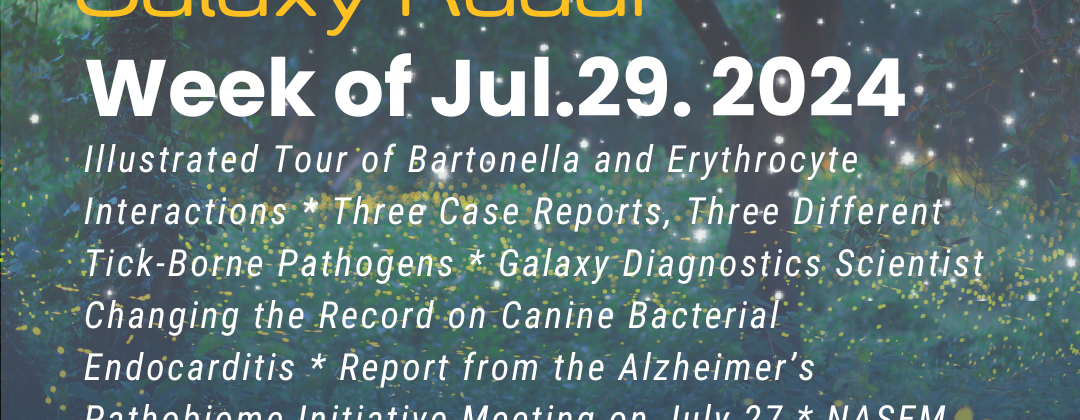HEADLINES: Illustrated Tour of Bartonella and Erythrocyte Interactions * Three Case Reports, Three Different Tick-Borne Pathogens * Galaxy Diagnostics Scientist Changing the Record on Canine Bacterial Endocarditis * Report from the Alzheimer’s Pathobiome Initiative Meeting on July 27 * NASEM Expert Panel Holds First Meeting on Lyme IACI * More
Illustrated Tour of Bartonella and Erythrocyte Interactions
Molecular Mechanisms of Bartonella and Mammalian Erythrocyte Interactions: A Review by H Deng, Q Pang, B Zhao & M Vayssier-Taussat publishing from Shandong University of Technology and the Université Paris-Est Créteil Val-de-Marne, Maisons-Alfort – This paper walks through how Bartonella species infect erythrocytes, with explanatory graphics.
Three Case Reports, Three Different Tick-Borne Pathogens
Paws and Pathogens: A Multidisciplinary Approach Through Bartonella henselae Endocarditis and Hepatosplenic T-Cell Lymphoma by ZI Sulaiman et al. publishing from the Medical College of Georgia and WellStar MCG Health – A 23-year-old was diagnosed with T-cell lymphoma. His symptoms overlapped Bartonella henselae infective endocarditis, which was diagnosed at a subsequent medical visit. His antibiotic therapy was adjusted to fit his chemotherapy, with a plan to continue daily antibiotic therapy until he could have heart surgery. Unfortunately, his health status left him with several risk factors for the stroke that ended his life before he could have that surgery.
Rare Presentation of Pediatric Nervous System Lyme Disease: A Case Report by I Khurtsilava, D Kanjaradze, N Tsirdava, T Parulava & I Darsania publishing from Tbilisi Pediatric Private Clinic and Tbilisi Medical Academy – A 4-year-old child in the nation of Georgia had mood changes, behavioral issues and seizures. After a series of negative tests, clinicians tested for Lyme disease; the result was positive. The child’s mother remembered a rash, but not exactly what it looked like. Antibiotic treatment led to improvement, but behavior changes persisted.
Acute Meningoencephalitis Associated with Borrelia miyamotoi, Minnesota, USA by JM Kubiak, M Klevay, EE Hilt & P Ferrieri publishing from University of Minnesota Medical Center and St. Paul Infectious Disease Associates – An immunosuppressed man who remembered several tick bites had 5 weeks of headaches, double vision, hearing problems and neuropsychiatric changes. Blood and cerebrospinal fluid serology was negative. Microscopy showed spirochetes, prompting PCR testing which was also negative. After he was discharged from the hospital, his 16S ribosomal sequencing results came in showing Borrelia miyamotoi.
Diagnosis of tick-borne disease continues to be delayed by nonspecific symptoms, overlap with other disease conditions and laboratory testing that has a high rate of false negatives even when clinicians have managed to narrow down the correct pathogen to test for. These issues lead to delayed diagnosis and in one of the case reports here, death. These tragic and frustrating outcomes, which many who are now doing this work have experienced personally, are why we are driven to improve clinical testing and diagnosis.
Review the test menu at Galaxy Diagnostics.
Galaxy Diagnostics Scientist Changing the Record on Canine Bacterial Endocarditis
Canine Bacterial Endocarditis: A Text Mining and Topics Modeling Analysis as an Approach for a Systematic Review by A Previti et al. publishing from University of Messina and Istanbul University-Cerrahpasa – A literature review revealed that bacterial endocarditis in dogs is attracting increased research attention, with Dr. Breitschwerdt of Galaxy Diagnostics and other Bartonella researchers making a significant contribution to the publication topics.
Report from the Alzheimer’s Pathobiome Initiative Meeting on July 27
The Alzheimer’s Pathobiome Initiative meeting on July 27 featured researchers, including Galaxy Diagnostics’ Dr. Ed Breitschwerdt, presenting on infectious causes of #Alzheimers disease. The meeting and research presented were personally meaningful to our CEO Nicole Bell, whose husband’s death from Alzheimer’s disease followed infection with Borrelia burgdorferi, Bartonella henselae, Candida albicans and reactivated HSV-1.
More about the meeting can be found here: https://www.alzpi.org/symposium-2024

MORE: Could Lyme Disease Involve a Cytotoxin? * Wisconsin Tick-Borne Disease Data, Looking at Anaplasmosis * Olympic Athlete Reports History of Lyme Disease * Vector-Borne Pathogens Everywhere You Look * Travel Medicine Questions Raised by Dengue * Reverse Zoonosis of SARS-CoV-2 in Pets and Wildlife * Galaxy Diagnostics Calendar
Could Lyme Disease Involve a Cytotoxin?
Borrelia burgdorferi 0755, a Novel Cytotoxin with Unknown Function in Lyme Disease by ST Donta publishing from Boston University Medical Center and Falmouth Hospital – Genetic analysis of Borrelia burgdorferi reveals it may have the ability to generate a toxin that has similar properties to those created by C. difficile and C. botulinum. The biology of when and where the toxin may be released requires further research.
Wisconsin Tick-Borne Disease Data, Looking at Anaplasmosis
Anaplasmosis: Wisconsin Data by Wisconsin Department of Health Services – Wisconsin has updated their Illnesses Spread by Ticks tracking. With anaplasmosis coming in second after Lyme disease as the most common tick-borne infections in the state, the case map provides more specifically regional information.
Olympic Athlete Reports History of Lyme Disease
Sarah Voss: Lyme Diagnosis Creates Bumpy Road to Paris by S Cooper on the GymCastic website – Diagnosed with mononucleosis, Olympic gymnast Sarah Voss continued to have extreme fatigue. She was diagnosed with Lyme disease (an earlier version of the article said babesiosis).
Vector-Borne Pathogens Everywhere You Look
Prevalence and Genetic Diversity of Bartonella spp. in Wild Small Mammals from South Africa by TA Mhlanga, S Chitanga, S Matthee, MP Malatji and S Mukaratirwa publishing from University of KwaZulu-Natal, University of Zambia and Stellensbosch University – A study of Bartonella in small mammals across a variety of locations in South Africa found three known zoonotic species as well as unknown species. The species, known and unknown, clustered in 5 genetic groups.
Molecular Survey on the Occurrence of Tick-Borne Bacteria in Wild Birds from Central Italy by F Bertelloni et al. publishing from the University of Pisa and CRUMA-LIPU – The spleens were collected from 300 dead birds in Tuscany, Italy, and tested for tick-borne zoonotic pathogens. 18% of the birds carried at least one pathogen, with one bird positive for a Bartonella species.
Vector-borne zoonotic pathogens can go unnoticed until research surfaces their presence. This story goes back to when the causes of the Black Plague were mysterious, to trench fever and more recently into the discovery of Bartonella henselae in AIDS patients. Surveys of animals more often than not turn up genetic variants of Bartonella that have not previously been seen, or hosts that are not generally prioritized as risk factors.
Travel Medicine Questions Raised by Dengue
Dengue Fever’s Worrisome Surge by CP Dunavan in MedPage Today – Despite working at UCLA, patient travel means this physician has treated dengue. Traveling raise questions about issues like how to advise patients about prevention and treatment options not available in the physician’s and traveler’s home region.
Reverse Zoonosis of SARS-CoV-2 in Pets and Wildlife
The Transmission of SARS-CoV-2 from COVID-19-Diagnosed People to Their Pet Dogs and Cats in a Multi-Year Surveillance Project by AK Kimmerlein et al. publishing from VCA and Antech Diagnostics – Transmission of SARS-CoV-2 between people and their pets has been the subject of few publications. In this study of 1000 dogs and cats owned by VCA employees in the US, 33% of dogs and 27% of cats were seropositive in correlation with human case rates. Most of the animals slept in the same bed and had other close contact with their humans when the humans were COVID-19 positive. 13% of the dogs and 23% of the cats had symptoms when their human was positive.
Widespread Exposure to SARS-CoV-2 in Wildlife Communities by AR Goldberg et al. publishing from Virginia Tech – In a serology study of 23 species of wildlife, six species also received nasal swabs and 23 animals that were RT-qPCR positive were found. Sequencing suggested multiple recent reverse-zoonosis transmissions. Animals that were seropositive were more likely to be in areas used by humans.
Earlier this year, we shared a blog post from BugBitten with more discussion of reverse zoonosis. One Health is sometimes conceptualized with human health at the center and risk flowing one way, but One Health is a web of interrelationships between humans, animals and the environment.
Galaxy Diagnostics Calendar
Project Lyme Gala on September 24, 2024 – Meet Galaxy Diagnostics CEO Nicole Bell and Cofounder Amanda Elam at the event.
ILADS Annual Scientific Conference, November 7-10, 2024 – Galaxy Diagnostics speakers will include CEO Nicole Bell. Find us in the exhibitor hall.






